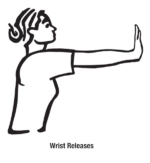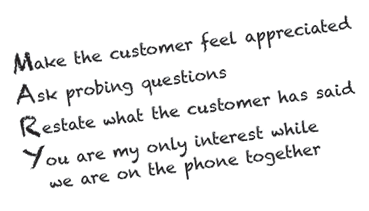Seated Relaxation
 Description This fun exercise will convince even the most reluctant participant that there is real value in practicing simple relaxation techniques when stressful situations arise. Participants will hold an ice cube in one hand for one minute. After a short break, they repeat this while doing a relaxation exercise. The exercise demonstrates that deep breathing…Full content with purchase
Description This fun exercise will convince even the most reluctant participant that there is real value in practicing simple relaxation techniques when stressful situations arise. Participants will hold an ice cube in one hand for one minute. After a short break, they repeat this while doing a relaxation exercise. The exercise demonstrates that deep breathing…Full content with purchase
 Description Each day your staff interacts with customers, coworkers, and supervisors. Each of these interactions is a potential source of stress. This easy to teach activity will give reps useful stress reduction tools that they can use at any time. This activity was adapted from the booklet Yoga at Your Desk. Materials A relaxing Impossible…Full content with purchase
Description Each day your staff interacts with customers, coworkers, and supervisors. Each of these interactions is a potential source of stress. This easy to teach activity will give reps useful stress reduction tools that they can use at any time. This activity was adapted from the booklet Yoga at Your Desk. Materials A relaxing Impossible…Full content with purchase
 Description This is a fun way to refresh skills during Customer Service Week. It can be used at any time to add a little spontaneous fun and training to the day. Consider introducing it during an ice cream sundae break, pot luck lunch, or any other time that people are gathering. Materials Small paper bag…Continue reading
Description This is a fun way to refresh skills during Customer Service Week. It can be used at any time to add a little spontaneous fun and training to the day. Consider introducing it during an ice cream sundae break, pot luck lunch, or any other time that people are gathering. Materials Small paper bag…Continue reading


This fun activity demonstrates the importance of clear communication and some of the pitfalls when instructions are ambiguous. This activity was adapted from The Customer Service Activity Book.
A jacket or sweater which buttons up the front
Ask the group to form a circle around you. You should be wearing the jacket.
Ask for a volunteer or select someone to participate in the activity with you.
Explain that it is not only important for service professionals to listen carefully to understand customers’ needs and wants, but that reps must also speak clearly and concisely so that customers understand them.
Next, explain the activity. Focus on the volunteer and say, “All I want you to do, standing right where you are, is to give me verbal directions and tell me how to put on my jacket. As you say this, take off your jacket, and as you are doing this, pull one of the sleeves inside out. Then, take off the jacket, ball it up and drop it on the floor. What follows is often very funny.
Now, listen very carefully to the volunteer’s instructions and do exactly what they say. Have fun with it. If the volunteer says, pick up your jacket, pick it up as a ball. If they say turn the sleeve inside out. Turn the correct sleeve the wrong way. If they say button the jacket, misalign the buttons and holes, and so on.
This activity demonstrates the importance of precise communication. How can we apply this to our daily work?
Do we provide specific directions, either written or spoken that seem to confuse customers?

This activity reinforces the idea that there are many ways to give great, personal service. Each participant uses the letters of their name to suggest service-oriented actions. This activity was adapted from the activity book, The Big Book of Customer Service Training Games.
Note Pads and Pens for each participant.
Flip-chart or white board and markers for the leader.
Ask each participant to write their first name vertically down the center of a sheet of paper. Demonstrate by writing the following on the flip-chart or white board:![]()
Next, ask participants to use each letter of their name to come up with an action that they can take to offer great customer service. For example: 
Finally, ask each participant to read their list out loud for the group.
Where there any common solutions or themes in the answers? (For example, did several participants focus on listening or empathy?)
Were there any especially creative, or even funny, solutions?
Were there several solutions for a single letter such as M? Ask reps to read their solution to just a single letter and discuss the many, many ways that customers and reps think about great service.


Frontline reps will share service stories and develop a list of what to do and what not to do when working with customers.
Paper and pen, or white board and marker, for the leader.
First, draw a line down the center of the paper. Label one side, “What to Do,” and the other side, “What NOT to Do.”
Ask participants to think of the best experience they have ever had with a customer service rep. Invite three or four people to share their experiences. As they are telling their stories, add key words and phrases in the column headed, “What to Do.” For example, listened, asked great questions, really cared, etc.
Now, ask participants to think of the worst experience they have ever had with a customer service rep. Again, invite three or four people to share their experiences. Add key words and phrases in the column headed, “What NOT to Do.” For example, interrupted, ignored, argued, etc.
This activity works well when the leader shares handwriting on screen via Zoom or another collaboration platform. Discussion will be ongoing while the leader takes notes which are viewed by all participants.
After the activity is completed ask everyone to take a quiet moment later in the day to think about their own work and to ensure that it reflects the team’s dos and don’ts.
Return to Customer Service Week Activities


This simple exercise will focus attention on the importance of active listening by illustrating how information can become lost or distorted.
Copies of the “story” for all observers
Have the group arrange their chairs classroom style or around a table.
Assign five or six people to be the participants. The remainder will be observers. Ask all but one of the participants to briefly leave the room. While they are gone, read a short story to the remaining people. Explain that the story will be retold and that the observers should note any errors or changes that occur.
Now invite one participant back into the room. Ask the first participant to tell the story to the second. Invite one more participant back into the room. Ask the second participant to tell the story to the third. Continue until everyone is back in the room and the last participant has shared the story with the group.
Finally, ask the observers to relate what elements of the story were changed or omitted.
Take a few moments to discuss the perils of lost or distorted information when working with customers. For example:
Sample story:
The Texas spirit of fun and hospitality lights up Paseo Del Rio, the San Antonio Riverwalk. This festive and popular travel destination shimmers with color and light. Along the left bank, two lines of brightly colored café umbrellas shelter outdoor diners and adorn the cobblestone walk. Above the rainbow rows of umbrellas, white lights strung between oak trees along the walking path glimmer softly in the dusk.
Return to Customer Service Week Activities


This activity was adapted from the activity book, The Big Book of Customer Service Training Games.
In this activity, participants practice picking up clues that can help them build rapport with customers. Building rapport, or creating a bond of trust, will help ensure productive relationships with customers even in the most trying times.
A small gift for each participant to take away
Prepare for this activity by cutting out magazine photos of people in everyday situations. You’ll need three to four photos per group.
Briefly discuss the concept of rapport. Explain that in this game participants will practice picking up clues from “customer” photos. These clues will be used to build connections with customers.
Divide your group into teams of two or three people. Give each team a selection of photographs. Ask them to come up with questions or statements that they might use to make pleasant, light conversation with the “customer” in the photo.
Provide an example to help the teams get started. For example, for a photo of a man in a Denver Broncos shirt with three children at his side you might say:
After about 10 minutes, ask the teams to share one or two of their photos and rapport-building questions or statements with the entire group.
Return to Customer Service Week Activities